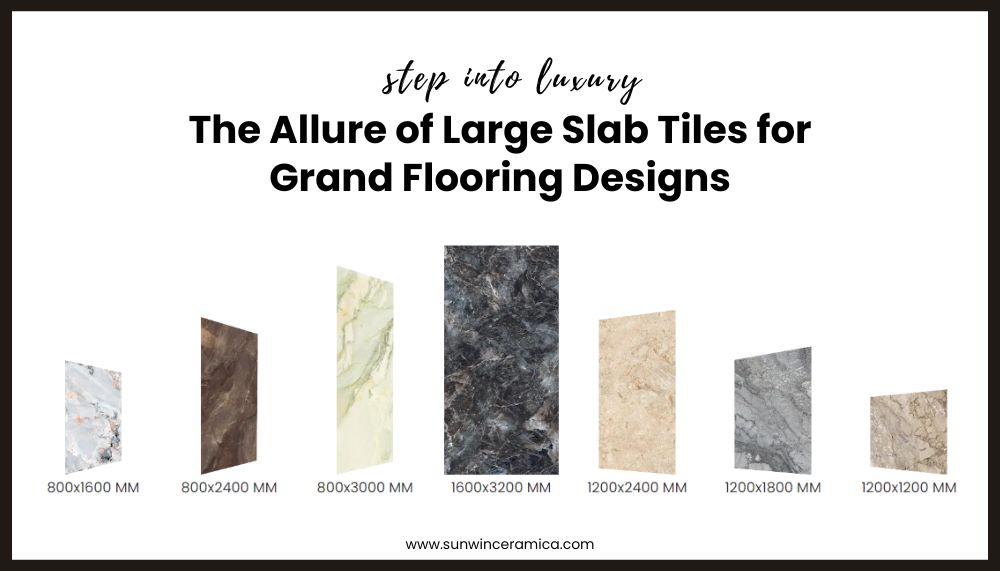
In recent days, homes are becoming more trendy with the availability of a huge variety of stylish decor options. Innovative designs of floor and wall tiles are increasing in popularity with this trend, especially with two magnificent creations of porcelain and vitrified tiles. These are the two most famous decor across the globe due to their beautiful textures and high-end durability. Both types have unique characteristics and features that make them stand out from others. But when it comes to choosing between these two, which one is better?
To pick the right choice for your home, you first need to understand the significant differences between these two variants of tiles. To make your task easier, we have brought you a comprehensive differentiation between vitrified tiles and porcelain tiles. Let's dive in and understand which one is a perfect match for you.
Raw materials and the manufacturing process of different tiles are responsible for their unique appearance and qualities. Therefore we are going to have a detailed look at the composition and properties of both tiles to make a clear differentiation.
Composition And Manufacturing Process
Composition And Manufacturing Of Porcelain Tiles

Porcelain tiles are manufactured using natural raw materials such as clay and feldspar to achieve their renowned characteristics. These raw materials are mixed together and molded into various shapes and sizes. After shaping, the tiles undergo a drying process that removes the extra moisture from the tiles making them stronger from inside. Thereafter these tiles are heated in extremely high temperatures ranging from 1200 to 1300 degrees Celsius to provide them their shining texture.
Properties of Porcelain Tiles
High Density: Firing porcelain tiles at extremely high temperatures makes them dense and highly resistant to cracking and breaking.
Low Porosity: Porcelain floor tiles have a smooth non-porous surface that prevents water absorption and helps to create a waterproof decor.
Stain Resistant: Due to the enhanced manufacturing process, these tiles can easily withstand rigorous activities without having any scratches on the surface.
Durability: Porcelain tiles are known for their exceptional durability. They are resistant to scratching, abrasion, and chemical damage, making them suitable for high-traffic areas in both residential and commercial settings.
Composition And Properties Of Vitrified Floor Tiles
Vitrified tiles contain mostly similar raw materials but a higher amount of silica for the glass-like appearance on the surface. Otherwise, the composition merely changes in both tiles. The mixture of raw materials undergoes a method known as wet-milling, which includes the following steps,
- Preparation of fine powder of the mixed raw materials.
- Adding water to create a slurry.
- Casting the slurry into molds to give different shapes and sizes.
Properties of Vitrified Tiles
High Strength: Vitrified tiles are known for their exceptional strength. The vitrification process during firing results in a compact and dense material that is resistant to breakage and can withstand heavy loads and impacts.
Color Retention: These tiles have excellent color retention properties. They are resistant to fading due to exposure to sunlight and retain their original appearance for a long time.
Resistance to Abrasion and Scratches: Vitrified tiles exhibit excellent resistance to abrasion and scratches. This property makes them highly suitable for high-traffic areas, as they can withstand the wear and tear caused by foot traffic and the movement of furniture.
Difference In Appearance
1. Color options

Porcelain tiles bring a versatile range of colors starting from neutral earthy tones to modern contemporary hues. Porcelain tiles present an excellent choice to mimic natural colors for creating a stunning visual appearance and adding a sense of depth to any space.
Vitrified tiles also showcase a brilliant market of mesmerizing hues but they mostly give a sense of modern decor style. Their glossy surface enhances the richness of colors producing a visually charmed look which also improves the optical spaciousness of the room.
2. Impact On Space Design

Porcelain tiles with their wide range of color and texture options offer versatility and the ability to create various moods. They can be used to achieve a classic, elegant look with marble look tiles or a warm and cozy atmosphere with wood-look tiles. Porcelain tiles can blend seamlessly into different design themes, whether it's a contemporary, traditional, or rustic style.
Vitrified tiles, particularly those with glossy finishes, add a touch of sophistication and modernity to a space. They can make a room appear larger and more luminous by reflecting light. Vitrified tiles with bold and vibrant colors or unique patterns can serve as a focal point and make a design statement in a room.
3. Cost

The cost is a significant factor when it comes to choosing between the two. Here the cost of products can vary on multiple factors such as manufacturing process, raw materials, size, thickness, etc. But generally, it's seen that porcelain tiles are purchased at higher rates than vitrified floor tiles. Let's understand why:
Manufacturing process: The production of porcelain tiles requires more complex steps and therefore sometimes costs more than vitrified tiles for customizable designs.
Raw materials: As we have discussed previously, the composition of porcelain tiles often includes a higher temperature and high-quality materials which can be the reason behind higher charges.
A variety of designs: Porcelain tiles carry various design that provides your space with a premium look. Therefore it costs a little more than other tiles.
The cost of tiles is an important consideration when planning a home design project. The budget for the project can be influenced by the cost of tiles, as they often account for a significant portion of the overall expenses. Opting for porcelain tiles, which are generally more expensive, may require a larger budget compared to choosing vitrified tiles.
Conclusion
Both porcelain and vitrified tiles are excellent options for providing your home with an appealing look but at the same time, both have their advantages and disadvantages. It depends on your choices and the need of the project as well as on the budget for choosing the perfect one. Consider the above factors and evaluate your needs to make a wise choice.
You May Also Like:



















